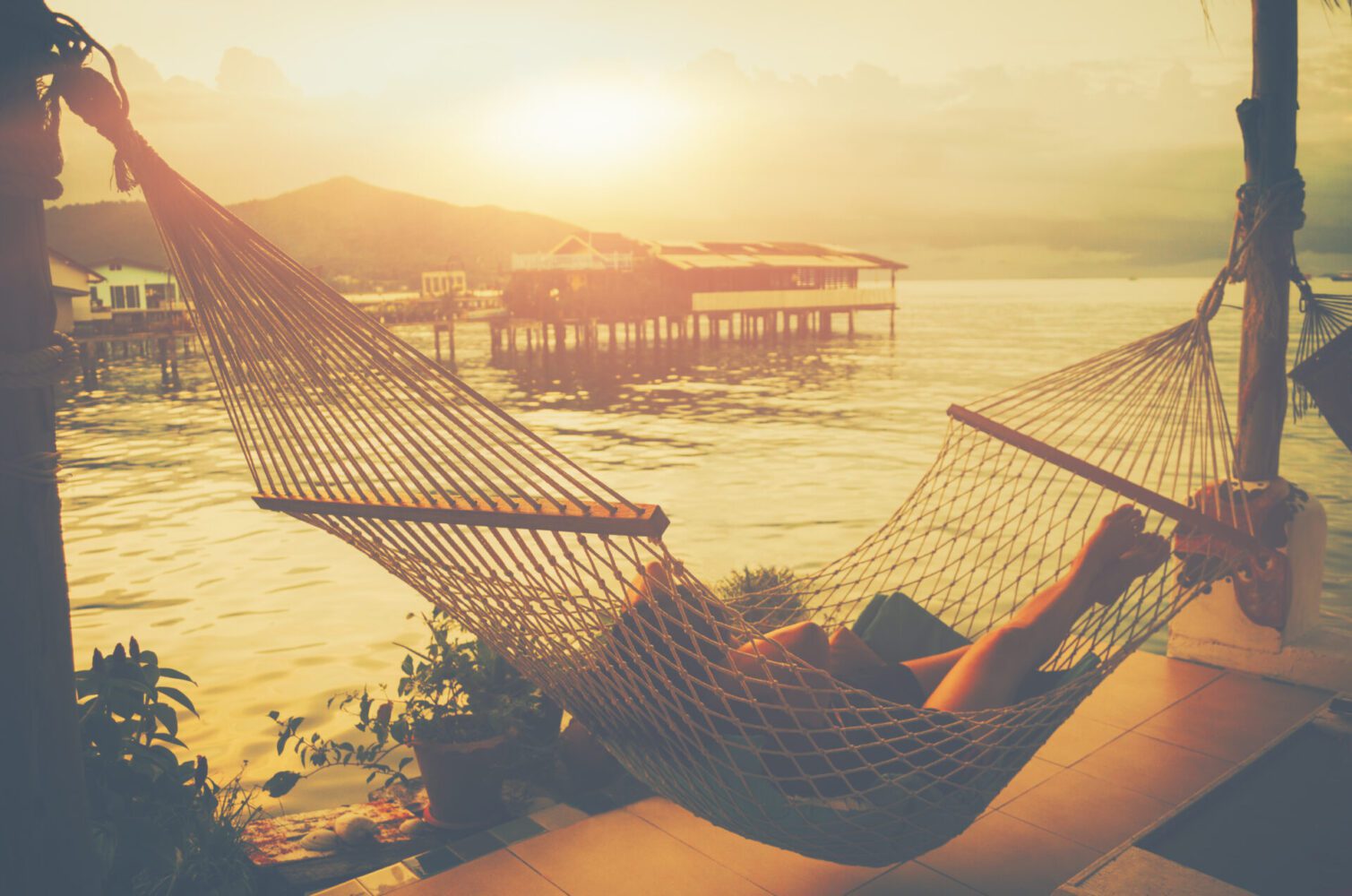
Tiết kiệm ánh sáng ban ngày đã là một chủ đề nóng trong một thời gian. Khi nói đến nó, luôn có cuộc tranh luận về việc chúng ta có nên áp dụng nó hay không và nó làm hỏng rất nhiều người trong chúng ta như thế nào! Cho dù bạn hào hứng với mùa hè hay sợ mùa đông đến mức nào, việc tiết kiệm ánh sáng ban ngày có thể ảnh hưởng rất lớn đến lịch trình giấc ngủ của bạn, đặc biệt là nếu bạn có con nhỏ. Trẻ nhỏ có khả năng chịu đựng tình trạng thiếu ngủ thấp hơn người lớn và sự thay đổi trong thói quen và thời gian ngủ có thể ảnh hưởng đến khả năng tập trung, cảm giác thèm ăn và tâm trạng chung của trẻ. Bất kể bạn bao nhiêu tuổi, thật không dễ chịu khi thức dậy trong tình trạng mệt mỏi, buồn tẻ, uể oải và không sảng khoái cho ngày mới. Chưa kể đến việc thay đổi giờ tiết kiệm ánh sáng ban ngày có liên quan đến việc tăng các sự kiện thể chất, bao gồm các vấn đề về tim mạch và sức khỏe tâm thần. Tin tốt là bạn có thể giúp cơ thể cân bằng trở lại nếu bạn biết phải làm gì. Sau đây là những mẹo hàng đầu của chúng tôi để giúp cơ thể và tâm trí bạn vượt qua những thách thức của việc tiết kiệm ánh sáng ban ngày một cách liền mạch.
Nội dung
1. Ra ngoài lúc bình minh
Khi những ngày dài hơn HOẶC ngắn hơn, hãy tận dụng tối đa ánh sáng mặt trời có sẵn và ra ngoài trời. Hormone của chúng ta cần nhận được tín hiệu từ mặt trời trong suốt cả ngày, bất kể thời tiết như thế nào. Hormone và nhịp sinh học của chúng ta cần biết thời gian trong ngày và mùa nào. Ngắm mặt trời mọc kích hoạt chuỗi hormone và chất dẫn truyền thần kinh và các chất cân bằng nội môi khác trong cơ thể cần thiết cho sức khỏe tối ưu. Sự cân bằng của melatonin và cortisol đặc biệt chịu ảnh hưởng của ánh sáng mặt trời vào sáng sớm. Một lượng nhỏ melatonin trong tế bào được tạo ra cả ngày trong các tế bào của chúng ta thông qua việc tiếp xúc với ánh sáng hồng ngoại từ mặt trời, trong khi tuyến tùng giải phóng nhiều melatonin hơn khi bóng tối buông xuống vào ban đêm. Melatonin là hormone gây ngủ của cơ thể chúng ta, nhưng nó cũng là một chất chống oxy hóa mạnh hỗ trợ việc sử dụng vitamin D.
Vì vậy, giấc ngủ sâu bắt đầu từ lúc mặt trời mọc. Duy trì thói quen cơ bản này trong suốt cả năm bằng cách thay đổi thời gian thức và ngủ để phù hợp với thời gian mặt trời mọc, KHÔNG phải thời điểm trong ngày. Làm như vậy có nghĩa là nhịp sinh học của bạn sẽ không "hoảng loạn" khi đồng hồ được chỉnh lại hoặc chỉnh lên khi thay đổi giờ tiết kiệm ánh sáng ban ngày. Bạn có thể cần dậy sớm hơn và đi ngủ sớm hơn một giờ trong thời gian chuyển đổi sang mùa thu, nhưng chỉ theo những gì đồng hồ chỉ. Nếu bạn đã tuân theo mô hình ánh sáng mặt trời, bạn sẽ không nhận thấy. Trong thời gian chuyển đổi sang mùa xuân, điều này sẽ diễn ra theo hướng khác. Điều này có thể là thách thức đối với những người có thời gian cố định cho công việc, trường học, v.v., vì vậy hãy xem #2 trong danh sách này, "Kiểm soát ánh sáng", để biết các mẹo về cách hạn chế ánh sáng nhân tạo sáng khi trời tối vào buổi sáng hoặc ban đêm. Ngay cả khi bạn cần "bám sát đồng hồ" để làm việc vào buổi sáng, việc đi ngủ sớm hơn một giờ vào mùa thu sẽ giúp bạn đối phó với việc thức dậy cùng mặt trời vào ngày hôm sau.
Với trẻ em, điều quan trọng là tạo ra một thói quen giúp chúng đạt được ngủ. Điều này sẽ giúp trẻ trưởng thành khỏe mạnh. Đưa trẻ đi xe đạp hoặc đi bộ vào buổi tối trong mùa hè; điều này sẽ cân bằng tâm trạng của trẻ, khiến trẻ vui vẻ hơn khi đi ngủ. Cho trẻ ngắm bình minh và hoàng hôn để tăng cường kiến thức của trẻ về cách hỗ trợ hormone lành mạnh khi trẻ lớn lên và phát triển.
Khuyến nghị nên tắm nắng ít nhất 30 phút mỗi ngày ở New Zealand: vào mùa hè, thời điểm này nên là vào cuối buổi chiều hoặc sáng sớm khi ánh nắng mặt trời dịu hơn. Vào mùa đông, thời điểm này có thể là bất kỳ thời điểm nào trong ngày. Ánh sáng hồng ngoại và UVA đặc biệt quan trọng đối với hormone của bạn, cùng với nhiều lợi ích khác. Thời gian tắm nắng phụ thuộc vào mức độ nhạy cảm của da với ánh sáng mặt trời, nhưng vào mùa hè, ánh sáng mặt trời vào sáng sớm có thể giúp da bạn phục hồi tốt hơn với ánh sáng mặt trời vào buổi trưa, trong khi ánh sáng mặt trời vào cuối buổi chiều hỗ trợ quá trình phục hồi da hàng ngày. Vào những tháng ấm hơn, ánh sáng mặt trời tất nhiên là nguồn cung cấp vitamin D - hỗ trợ tâm trạng, giấc ngủ, hệ miễn dịch và xương tự nhiên. Người ta tin rằng 27 phần trăm số người có lượng vitamin D trong máu thấp hơn mức khuyến nghị và một số vấn đề sức khỏe làm tăng nhu cầu vitamin D. Chỉ có ánh sáng UVB mới có thể kích hoạt quá trình chuyển đổi D3 và nó chỉ xuất hiện vào giữa ngày vào một số thời điểm nhất định trong năm. Một ứng dụng như D-Minder có thể giúp bạn tìm thời điểm thích hợp để tắm nắng an toàn và sản xuất vitamin D. Tiếp xúc với ánh sáng tự nhiên không có nghĩa là bạn phải ngồi dưới ánh nắng mặt trời nóng và có nguy cơ bị cháy nắng. Che chắn hoặc tìm chỗ râm mát. Ngay cả khi ở trong bóng râm, bạn vẫn nhận được tín hiệu từ ánh sáng tự nhiên chiếu vào mắt.
Điều quan trọng nhất là cả gia đình luôn thức dậy vào lúc mặt trời mọc và đi thẳng ra ngoài, và bạn sẽ không nhận thấy sự chuyển đổi giờ mùa hè nhiều. Chỉ thức dậy trước khi mặt trời mọc nếu bạn phải làm vậy, theo thời gian.
2. Kiểm soát ánh sáng vào ban đêm
Tiếp theo là #1… Ra ngoài càng nhiều càng tốt vào ban ngày là điều rất tốt, nhưng bạn sẽ làm gì vào ban đêm khi tất cả đèn nhân tạo đều bật?
Melatonin tăng khi mặt trời lặn, gây buồn ngủ, và giảm khi mặt trời mọc và mức cortisol tăng, giúp “đánh thức” chúng ta. Điều cần thiết là tránh ánh sáng mạnh và ánh sáng xanh sau khi mặt trời lặn, hoặc trước khi mặt trời mọc nếu bạn phải dậy sớm để đi làm hoặc đi học. Bạn có thể sử dụng bóng đèn màu cam hoặc bóng đèn sợi đốt, nến và kính chặn ánh sáng xanh, và tránh các thiết bị và TV. Điều này trở nên quan trọng hơn vào mùa đông khi thời gian bóng tối kéo dài nhất.
Vào mùa hè, trẻ em có thể bối rối khi chúng ta yêu cầu chúng đi ngủ khi mặt trời vẫn còn sáng, đặc biệt là khi mức melatonin của chúng có thể không ở mức tối ưu. Để giúp melatonin tăng lên một cách tự nhiên, hãy yêu cầu chúng kéo tất cả rèm cửa xung quanh khu vực chúng dành thời gian trước khi đi ngủ và bật đèn mờ màu cam/đỏ ở những khu vực này. Đảm bảo rằng tất cả các thiết bị điện tử và thiết bị đều tắt một giờ trước khi đi ngủ, vì việc tiếp xúc với ánh sáng xanh, cũng như sự kích thích não bộ từ những gì chúng đang xem, có thể ức chế sự giải phóng melatonin, ngay cả khi mặt trời vẫn còn thấp trên bầu trời. Vào buổi sáng, hãy đảm bảo trẻ em được tiếp xúc với ánh sáng tự nhiên vào lúc mặt trời mọc: ăn sáng bên ngoài, đi dạo quanh khu nhà trước khi đến trường hoặc chỉ cần đảm bảo rèm cửa và cửa sổ được mở ngay khi chúng thức dậy. Kính cửa sổ chặn toàn bộ quang phổ ánh sáng từ mặt trời.
3. Tìm đến magiê để được hỗ trợ thêm
Magiê nuôi dưỡng hệ thần kinh và hỗ trợ thư giãn, giúp melatonin hỗ trợ chu kỳ ngủ/thức lành mạnh trong cơ thể. Vì chế độ ăn uống hiện đại, siêu chế biến thường thiếu magiê, nên điều quan trọng là chúng ta phải tập trung vào việc ăn thực phẩm nguyên chất và thực phẩm giàu magiê hoặc bổ sung chế độ ăn uống. Các nguồn thực phẩm giàu magiê nhất bao gồm các sản phẩm từ sữa nguyên chất, cá, động vật có vỏ và gia cầm. Ngay cả thịt đỏ cũng chứa một lượng magiê sinh khả dụng tốt. Đảm bảo gia đình bạn có nhiều loại thực phẩm này trong suốt cả ngày, và đặc biệt là vào buổi tối, để giúp gây ngủ. Một số nguồn magiê trong chế độ ăn uống cao nhất đến từ các loại hạt và hạt giống, đặc biệt là hạnh nhân, hạt phỉ, hạt Brazil, hạt điều và hạt bí ngô; tuy nhiên, các khoáng chất trong hạt thực vật - hạt, hạt, đậu và ngũ cốc - liên kết với các hợp chất ngăn hạt nảy mầm quá sớm và do đó ít có khả năng tiêu hóa và hấp thụ của con người. Ngâm và kích hoạt có thể làm giảm tình trạng này, nhưng tốt nhất là không nên dựa vào hạt thực vật để có tất cả các khoáng chất của bạn.
4. Sử dụng thuốc thảo dược
Hoa lạc tiên, hoa anh túc California, hoa cúc, lá chanh, và hoa oải hương là một số loại thảo mộc mà chúng ta có thể sử dụng để hỗ trợ giấc ngủ. Những loại thảo mộc này có thể được sử dụng trong suốt cả ngày mà không gây buồn ngủ nhưng sẽ giúp ích vào giờ ngủ và hỗ trợ trẻ em ngủ ngon suốt đêm. Dùng như một chất bổ sung hoặc sử dụng thảo mộc tươi hoặc khô trong trà. Tinh dầu hoa oải hương có thể được xịt lên gối hoặc thêm vào bồn tắm để giúp thư giãn cơ thể và tâm trí trước khi đi ngủ.
Tiết kiệm ánh sáng ban ngày không thể thiếu một vài ngày chuyển đổi. Trong vài ngày đầu, hãy cố gắng tha thứ hơn, vì trẻ em có khả năng sẽ quá mệt mỏi và bực bội. Hiểu rằng đây chỉ là tạm thời sẽ giúp trẻ điều chỉnh tốt hơn. Điều chính cần ghi nhớ là thói quen đi ngủ tốt đảm bảo rằng trẻ nhỏ được nghỉ ngơi nhiều, ngay cả khi điều này có nghĩa là chúng phải ngủ trưa lâu hơn trong ngày. Cũng giống như trẻ em khó điều chỉnh, người lớn cũng vậy, vì vậy đừng quên chăm sóc bản thân! Tất cả những mẹo này đều có thể áp dụng cho các bà mẹ và ông bố, vì vậy hãy thực hành chúng với con bạn và giúp cả gia đình điều chỉnh một cách liền mạch.
Câu hỏi thường gặp
Giờ tiết kiệm ánh sáng ban ngày ảnh hưởng đến giấc ngủ và sức khỏe tổng thể như thế nào?
Giờ tiết kiệm ánh sáng ban ngày có thể làm gián đoạn giấc ngủ bằng cách thay đổi nhịp sinh học tự nhiên của cơ thể, dẫn đến khó ngủ hoặc thức dậy. Sự gián đoạn này có thể dẫn đến mất ngủ, mệt mỏi và tăng nguy cơ tai nạn và các vấn đề sức khỏe.
Magiê có thể giúp hỗ trợ chu kỳ ngủ/thức lành mạnh như thế nào?
Magiê đóng vai trò quan trọng trong việc hỗ trợ chu kỳ ngủ/thức lành mạnh. Nó hỗ trợ hệ thần kinh, giúp thư giãn tốt hơn và hỗ trợ giấc ngủ. Ngoài ra, thiếu magiê có liên quan đến các vấn đề về giấc ngủ, do đó, đảm bảo hấp thụ đủ magiê có thể hỗ trợ chất lượng giấc ngủ tốt hơn và sức khỏe giấc ngủ tổng thể.
TAPSPP1503

